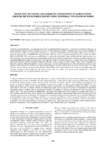Please use this identifier to cite or link to this item:
http://www.alice.cnptia.embrapa.br/alice/handle/doc/334106| Title: | Detecting outliers and asserting consistency in agriculture ground truth information by using temporal VI data from modis. |
| Authors: | ARVOR, D.  JONATHAN, M.   MEIRELLES, M. S. P.   DUBREUIL, V.   |
| Affiliation: | D. Arvor, Université Rennes; M. Jonathan, Université Rennes; MARGARETH GONCALVES SIMOES, CNPS; V. Dubreuil, Université Rennes. |
| Date Issued: | 2008 |
| Citation: | International Archives of the Photogrammetry, Remote Sensing and Spatial Information Sciences, v. 37, pt. B7, p. 1031-1036, 2008. Edition of Proceedings of XXI ISPRS Congress, Beijing, Jul. 2008. |
| Description: | Collecting ground truth data is an important step to be accomplished before performing a supervised classification. However, its quality depends on human, financial and time ressources. It is then important to apply a validation process to assess the reliability of the acquired data. In this study, agricultural infomation was collected in the Brazilian Amazonian State of Mato Grosso in order to map crop expansion based on MODIS EVI temporal profiles. The field work was carried out through interviews for the years 2005-2006 and 2006-2007. This work presents a methodology to validate the training data quality and determine the optimal sample to be used according to the classifier employed. The technique is based on the detection of outlier pixels for each class and is carried out by computing Mahalanobis distances for each pixel. The higher the distance, the further the pixel is from the class centre. Preliminary observations through variation coefficent validate the efficiency of the technique to detect outliers. Then, various subsamples are defined by applying different thresholds to exclude outlier pixels from the classification process. The classification results prove the robustness of the Maximum Likelihood and Spectral Angle Mapper classifiers. Indeed, those classifiers were insensitive to outlier exclusion. On the contrary, the decision tree classifier showed better results when deleting 7.5% of pixels in the training data. The technique managed to detect outliers for all classes. In this study, few outliers were present in the training data, so that the classification quality was not deeply affected by the outliers. |
| Thesagro: | Sensoriamento Remoto Uso da Terra |
| Keywords: | Processamento de imagens multitemporais Mapeamento de culturas |
| Type of Material: | Artigo em anais e proceedings |
| Access: | openAccess |
| Appears in Collections: | Artigo em anais de congresso (CNPS)  |










